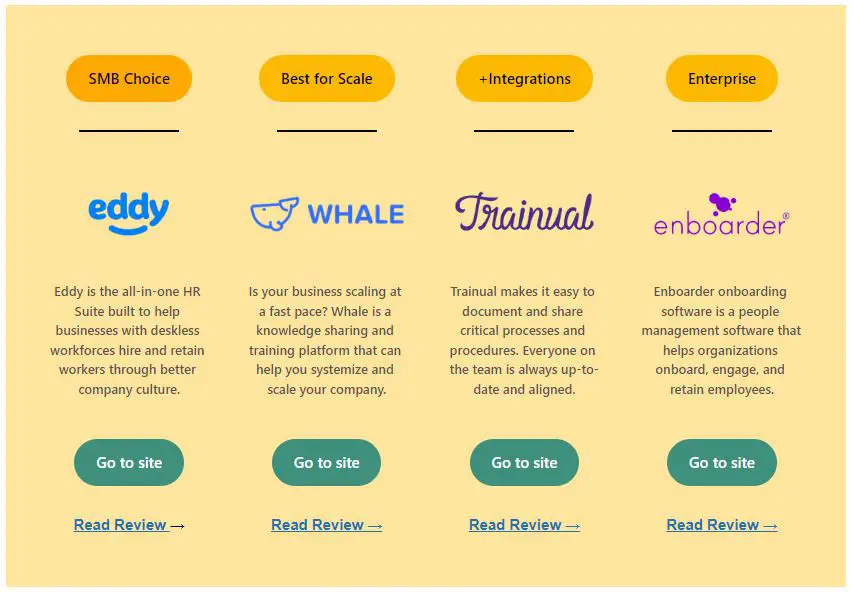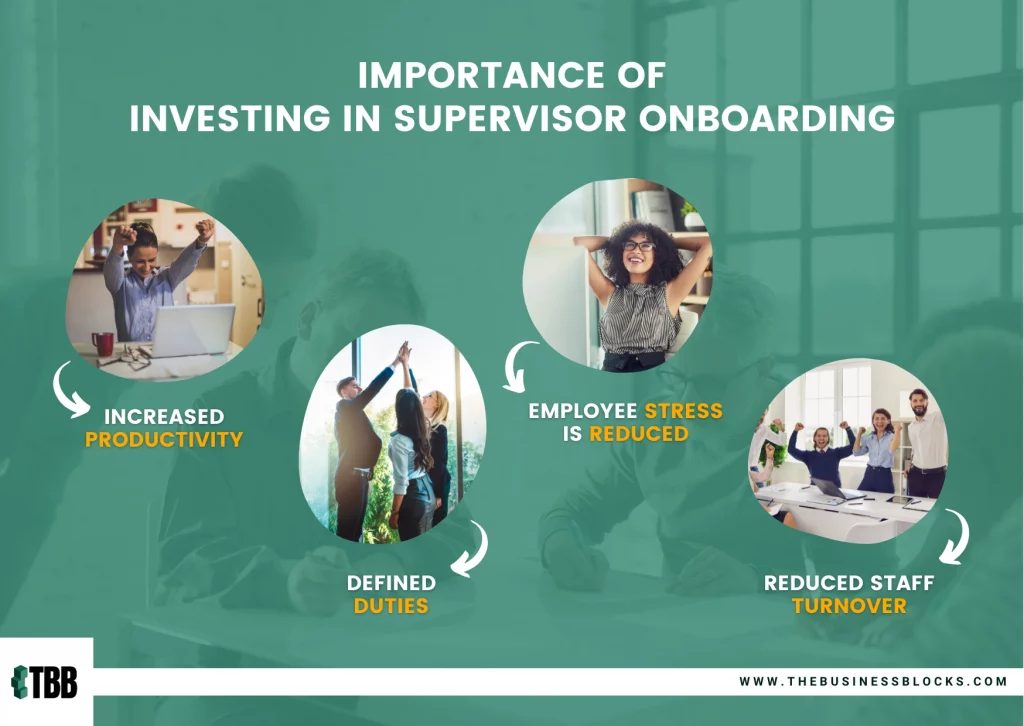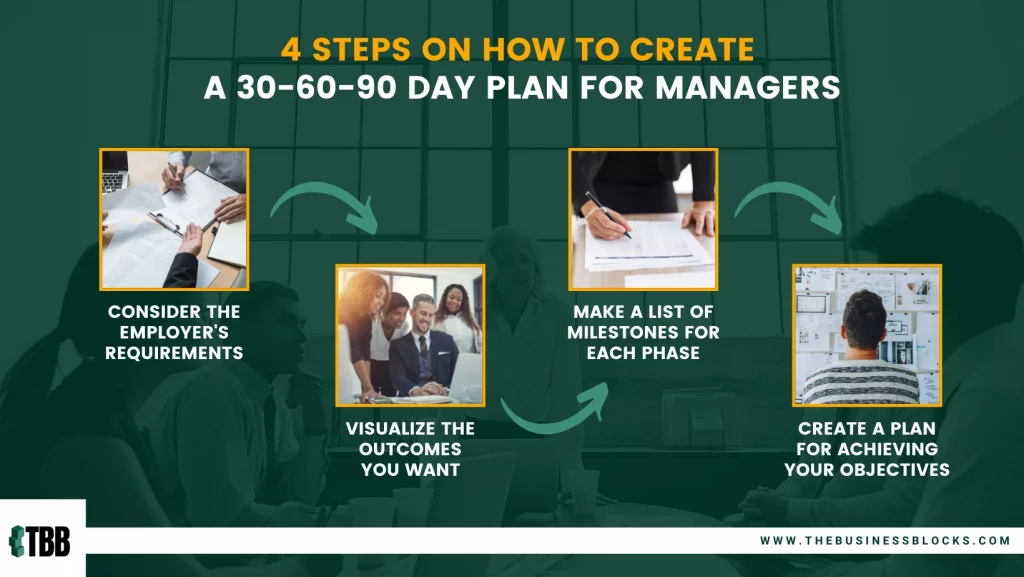We all know how important first impressions are for keeping employees but having a 30, 60, 90 Day Plan for Managers is far more strategic to get right!
An efficient and productive onboarding plan is one of the most acceptable ways to achieve this. And the manager is one of the people who will benefit from a dedicated onboarding program.
Let’s face it: managing people is no laughing matter. While managers don’t frequently get their hands dirty with the team’s technical duties, it doesn’t make their tasks any less demanding! Taking the reins and steering a group of individuals he doesn’t know maybe a stressful and challenging undertaking for a rookie manager.
A manager onboarding program might be the thing to help ‘bosses’ feel at ease in their skin from the first day on the job!
New to management? Looking for an Edge in your New role?
You’re in the right place. Here, we’ll show you a Four Steps to Your 30 60 90 Day Plan for New Managers strategy that will help you become successful as quickly and efficiently as possible. Putting together a plan is essential for any leader, and it gives hiring managers confidence that you can handle the position.
Utilizing this four-step approach will help establish yourself in your new role – so why not get started today? Every step provides concrete tips and advice on creating an effective plan while keeping it simple. With this guide, success can be yours!
What is manager onboarding, and how does it work?
The manager onboarding program helps teach the new manager about their duties, as well as an introduction for trainees and new hires.
This program does not have to be expensive or extensive; it may contain basic exercises like checklists, short films, how-to’s, and conferences with other departments such as HR, payroll, and so on because managers must connect with other teams.
Manager onboarding’s primary purpose is to give new managers the resources to succeed. After all, the firm has invested in recruiting the management, and now it must back up that choice by assisting new managers with a smooth transition.

Why is it important to invest in an excellent manager onboarding?

Low staff morale, poor engagement, poorer productivity, and a deteriorating employee experience are all blamed on bad management.
Statistics show that around 50% of senior management hires fail within the first 18 months of the company due to poor manager onboarding and unclear plans.
SHRM 2020
It’s important to remember that poor management techniques aren’t necessarily the consequence of the manager’s mistake. Some new managers are thrust into leadership positions with little or no training. They frequently have questions regarding their expectations, culture, work duties, and team dynamics.
Manager onboarding programs demonstrate that you care about your managers.
As a result, a cascade effect will occur, affecting their team members, coworkers, and direct reports. Below are the reasons why an excellent onboarding manager is essential:
- Increased productivity – When done correctly, employee onboarding may increase productivity by 54 percent. Remember that a people-first culture of a firm leads to more contented employees and a better knowledge of their roles. In addition to your company-provided onboarding, create a process so managers plan the first weeks for the new staff.
- Defined duties – Training on how to do the job is essential for employee onboarding. By describing the new employee’s expectations, onboarding brings the job description to life. The new employee should understand how their function fits within the team and the Company at the tail end of the onboarding process. Employee onboarding should make new hires feel like they’re a valuable part of the Company, motivating them to stay on the job and produce their best work.
- Employee stress is reduced — Starting a new job can be stressful for new workers. There’s a lot for new hires to consider, such as whether or not they will manage and how to handle their tasks. Business owners may help their recruits feel less anxious and stressed by welcoming them to the group and giving them all the tools and knowledge they need to succeed. New hires should be able to form relationships with current team members due to their onboarding. Early facilitation of healthy team connections will aid in forming solid groups in the future.
- Reduced staff turnover – It’s estimated that it costs six to nine months’ salary to replace an individual in a managerial role. This illustrates that if employees are unhappy at work, they will leave. As a result, firms must do all possible to keep good staff. Businesses may use onboarding to assist workers in becoming more involved in the company culture.
What is a 30, 60, 90 Day Plan and its benefits?
A 30-day, 60-day, and 90-day plan is a blueprint for what an employee wants to achieve in their new job’s first 30, 60, and 90 days. New managers frequently set short-term objectives and discuss ways to make a difference in their organizations.
The first month, for example, can comprise building connections with coworkers and understanding how procedures function. The manager’s goal for the second month can be to lead a modest project. The purpose of the third month may be to assess the group and develop long-term strategies for the business.
The length of the 30-day, 60-day, or 90-day plan is determined by the leadership responsibility and the member’s future goals. New managers frequently submit their proposals for approval to their superiors.
Professionals may demonstrate to their companies that they understand their job expectations and are considering methods to make positive changes by developing a clear strategy.
How to create a 30 60 90 Day Plan for Managers?

Create a 30-day, 60-day, or 90-day strategy for your new management role by following these steps: Create a 30-day, 60-day, or 90-day strategy for your new management role by following these steps:
- Consider the employer’s requirements – The criteria that the Company expects you to meet as an employee are known as the employer’s expectations. It would be best to consider how you’ll perform your work obligations in your 30-day, 60-day, and 90-day plans. Remember what the recruiting manager said about your responsibilities during the interview. You may also go back through the work description for content ideas for your outline. Incorporating your position expertise into your approach might demonstrate to your boss that you’re serious about taking action.
- Visualize the outcomes you want – The optimal results depict the situation after you’ve met your short-term objectives. They might be as simple as seeing yourself surpassing the employer’s expectations or as complex as considering your professional goals. For example, an organizational aim may be to build a safe, fast-performing mobile application, while a personal goal would be to expand your technical talents to mobile devices. Including both goals in your 30-day, 60-day, and 90-day plans will help you please your boss and boost your self-esteem.
- Make a list of milestones for each phase – The goals are your short-term objectives for your 30-day, 60-day, and 90-day plans, which you may use to measure your progress in transitioning to your new managerial position. Each outline phase may have various milestones depending on what you have learned throughout that time frame. You may also arrange your milestones chronologically so that you must complete one objective in 30 days before moving on to the next in 60 days. Make your milestones explicit and quantifiable to see if you’ve met them when each part of your plan is completed.
- Create a plan for achieving your objectives – The instructions are step-by-step guides that teach you how to attain your desired outcomes. Each step of your 30-day, 60-day, or 90-day plan requires directions for achieving the goal. Make sure your directions contain reasonable deadlines. Hosting team-building exercises, for example, could be better suited to the 30 days than the 90-day phase.
Template of a 30 60 90-Day Plan for Managers
As a manager, your 30-60 90-day plan provides precise targets you want staff to meet. Consider your new hire’s skills and weaknesses when creating goals. At each level, provide input on how they can improve.
Name: [New hire]
Manager:
Start date:
➡ DAY 1 – 30: Main priorities and goals
- Week 1
- Company onboarding
- Basic Product Training
- Week 2
- Learn systems and processes
- Initial meetings with cross-functional stakeholders and teammates
- Week 3
- Work with superiors to identify and set a measurement system for job success in the next six weeks.
- Week 4
- Deliver initial “quick win.”
➡ DAY 31 – 60: Main priorities and goals
- Week 5
- Take over necessary project ownership
- Week 6
- Present strategic plan to team
- Weeks 7-8
- Start strategy implementation
➡ DAY 61 – 90: Main priorities and goals
- Week 9-10
- Continually apply the strategy
- Week 11
- Check development against success system of measurement
- Work with superior to distinguish and set metrics for job achievement in the next six months
- Week 12
- Complete the ramp-up process
What’s the Most Important thing I should accomplish in the first 90 days?
Identify Company’sthe goals that should be achieved in the first 90 days from the Company’s key performance metrics or indicators and objectives. This may be completing a project, exceeding sales targets, or improving customer satisfaction. Use this goal as your main focus for your plan.
The most important thing you should accomplish in the first 90 days is to:
Establish yourself as a leader.
You must prove you know the job and can be trusted with important decisions. This means building relationships with colleagues and learning their processes, objectives, and challenges. It also involves developing a vision for the organization’s future and leading change initiatives.
You should develop trust and respect with your team.
This is essential for successful management. Your team should see you as a leader who can make decisions, provide guidance and direction, and offer support when needed. Building relationships with your team will also help them understand why certain objectives must be met and how they can contribute to achieving those goals. However, professional and personal levels of conversations are important to build trust and create a positive work environment.
Gathering Information and Assessing Your Team’s Knowledge
Take time to observe how each team member operates and their strengths and weaknesses. Ask questions about processes, procedures, and tasks to understand how they are managed. This is also a great way to identify opportunities for improvement or additional training needs. Metric Team’s existing strategy and performance against KPIs can offer insights on how to improve.
Communicate expectations and objectives.
With the Company’s mission and goals in mind, create a plan to achieve them. This Company’sld includes strategies for success and clear expectations for each team member. Clarify objectives, timelines, and responsibilities when setting expectations so everyone is on the same page. A good plan makes it easier for teams to succeed by allowing them to focus their efforts on achieving results. Your own team’s processes and KPIs will be important for tracking progress.
Developing an Action Plan
Create an action plan to help you meet the goals identified from the Company’s KPIs. Define goals, timelines, and resources necessary to complete each project. Assign tasks based on the strengths and weaknesses of team members. Your performance metrics should be included in this plan.
These are the important things you should accomplish in the first 90 days. Future success will depend on your ability to lead, build trust and respect, gather information and assess the team’s knowledge, communicate expectations and objectives, and develop an action plan. Good luck in your first 90 days as a manager!
Manager’s Core Job Responsibilities and Leadership Strategies
As a manager, you are responsible for the performance and development of your team. This includes:
- Setting goals and expectations.
- Providing guidance and feedback.
- Developing leadership strategies to help individuals reach their full potential.
Motivating staff to produce high-quality work by managing resources efficiently while maintaining a positive work environment.
Leadership Strategies
Developing a positive organizational culture and setting an example for others to follow is essential for successful leadership. This includes:
- Developing a vision and mission statement that will provide direction for the team.
- Building trust and respect with your team through communication, feedback, praise, and support.
- Encouraging collaboration among team members to solve problems or create new ideas.
- Establishing clear objectives and expectations and holding team members accountable for their performance.
- Providing training or guidance to help develop skills and knowledge.
- Developing an effective communication plan that will allow you to stay up-to-date on information related to the organization’s progress.
- Creating rewards or recognition systems for excellent performance.
Leadership is essential for any team’s success, and it is important to remember that you are the leader who will guide them through their journey together. Following these strategies and incorporating your competitive research can help your team reach its goals and foster a collaborative work environment.
With just as much fear, enthusiasm, and discipline as you had when you first started as a manager, you can surely lead your team to success.
Frequently Asked Questions About Four Steps to Your 30 60 90 Day Plan for Managers
Q: Why should hiring managers create a 30-60 90-day plan?
A: A 30-60 90-day plan is an effective way for hiring managers to understand the goals and objectives of their team. It also helps teams stay on track by providing clear expectations, timelines, and resources necessary to achieve results.
Q: Does the team achieve better results with a 30-60 90-day plan?
A: Yes, teams can focus on achieving results and stay on track when provided with clear expectations and objectives.
Q: What personal goals should I focus on as a manager?
A: As a manager, your personal goals should be focused on leading the team effectively, providing guidance and feedback, building trust and respect with team members, and encouraging collaboration to solve problems or create new ideas.
Q: Does the team’s work style and sales team need to be included in the 30-60 90-day plan?
A: It is important to include the team’s work style and sales processes in your 30-60 90-day plan. This will help you track progress over time and develop an action plan for achieving success.
Q: Why is assessing the team’s strengths and weaknesses important?
A: Assessing the strengths and weaknesses of your team can help you identify areas for improvement. This information can be used to set individual goals, provide guidance when needed, and develop an effective action plan to enable the team to reach its full potential.
Conclusion
Change may be difficult and daunting, but it does not need to be if you have a solid strategy and a team. Plans constantly change, so having the correct tools and resources to keep you and your group organized is important. For new managers, the first 30-60 days are crucial; the worst thing you can do is waste most of them in unnecessary meetings.

